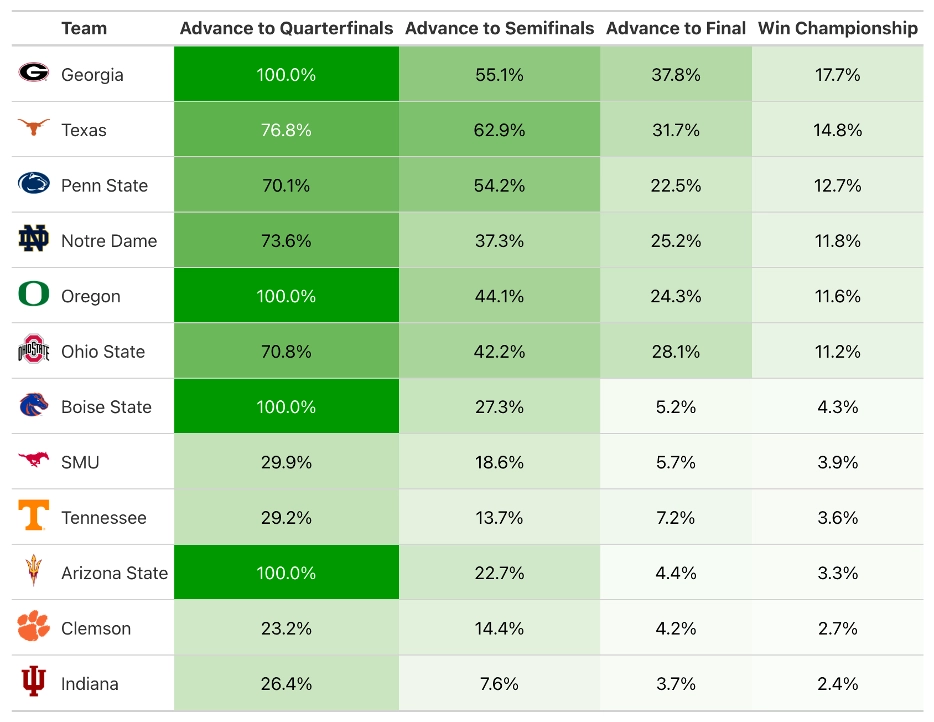
"Alabama crimson Tide" by Timothy Valentine is licensed under CC BY-SA 2.0.
In the wake of the College Football Playoff committee's controversial decision to select SMU over Alabama for the final playoff spot, our simulation model provides fascinating insights into what might have been. While the debate has largely centered on subjective factors - Alabama's strength of schedule versus SMU's conference championship game performance - we decided to let the numbers tell the story.
In our previous article entitled, “Predicting the 12-Team CFP Champion: A Monte Carlo Simulation Analysis of College Football's New Playoff Era” we simulated the CFP 10,000 times and found that Georgia is a slight favorite to win the championship and that there is a clear tier of “contenders” (Georgia, Texas, Penn State, Notre Dame, Oregon, and Ohio State) with simulated national championship percentages greater than 11%. The rest of the teams in the field checked in with championship chances less than 5%.

Percentage Chance to Advance to Each Round
One of the beauties of simulation modeling is the ability to game out “what-if” scenario. One such scenario we can look at addresses the controversy around the inclusion of SMU over Alabama. What if Alabama had been chosen instead of SMU? Let’s slot Alabama into SMU’s position in the bracket (a First-Round game, on road at Penn State) and see what might have happened. The results of 10,000 simulations of Alabama in playoffs in SMU’s spot are shown below.
Percentage Chance to Advance to Each Round (Alabama “What-If” Scenario)
The results are compelling: Alabama would have emerged as a serious contender, with an 11% chance of winning the national championship - placing them squarely in the tournament's top tier of favorites alongside Georgia, Texas, Penn State, Notre Dame, and Oregon.
What's particularly interesting is how Alabama's inclusion would have reshuffled the entire playoff landscape. The simulation shows Texas emerging as the new slight favorite, overtaking Georgia - a shift that speaks to the ripple effects of roster quality and matchup dynamics across the bracket. The model suggests that Alabama's presence would have significantly impacted the championship odds of several teams, particularly those on their side of the bracket including Penn State, Notre Dame, Indiana, Boise State and Georgia.
How Alabama’s Presence Would Transform Title Game Odds

Perhaps the most telling evidence of Alabama's potential impact comes from examining the simulated national championship matchups. In our original model with SMU, the Mustangs appeared in the title game in only 5.7% of simulations, with their most likely championship appearance (against Texas) occurring just 195 times in 10,000 runs. When Alabama replaces SMU in the bracket, the simulation paints a dramatically different picture. Alabama vs. Texas emerges as the fourth most likely championship matchup, occurring in 7.7% of simulations (772 times). Other potential Alabama championship matchups show similar strength, with the Crimson Tide facing Ohio State 644 times (6.4%) and Oregon 585 times (5.9%). Even an intriguing rematch with Tennessee appears 179 times (1.8%). These numbers suggest that Alabama wouldn't just participate in the playoff - they would significantly impact its highest-stakes games.

Saban and Byrne Offer Different Perspectives
Our analysis provides an intriguing counterpoint to Athletic Director Greg Byrne's concerns about strength of schedule being devalued. The simulation suggests that Alabama's strong schedule and quality wins would have translated into legitimate championship potential in the expanded format. However, as Nick Saban himself noted on the CFP selection show, "No coach should have any complaints about his circumstance about getting in the Playoff or being left out. They all controlled their own destiny and had opportunities."
While we'll never know how Alabama would have actually performed, the data suggests the committee may have faced an even tougher decision than initially apparent. The simulation positions Alabama as a legitimate contender rather than just the last team in or out - raising broader questions about how the committee weighs various factors in their selection process.
The debate over Alabama's exclusion will likely continue, but our analysis suggests that in an alternate universe, the Crimson Tide would have been more than just a participant - they would have been a legitimate threat to win it all.
Author
Dr Stephen Hill, Associate Professor of Data Analytics in Samford University's Brock School of Business and the Center for Sports Analytics
